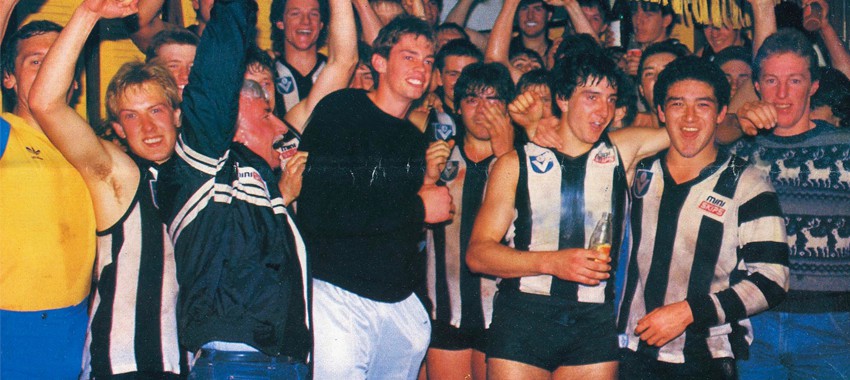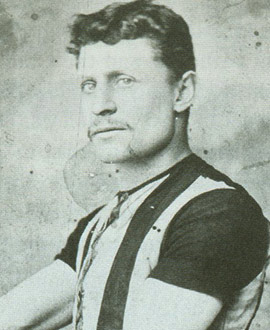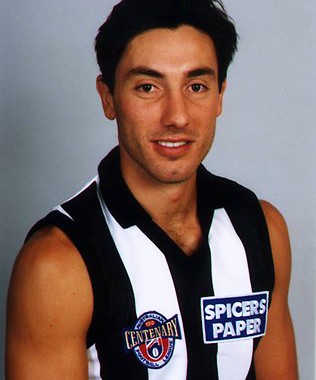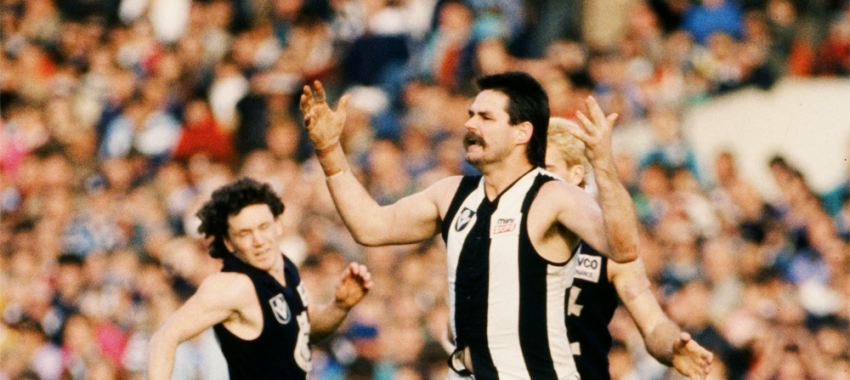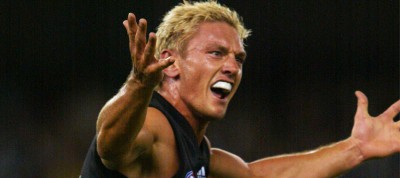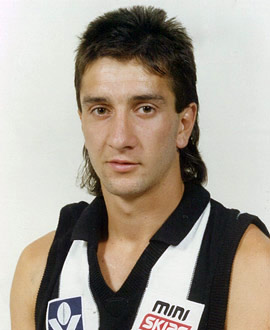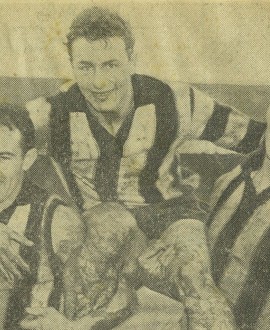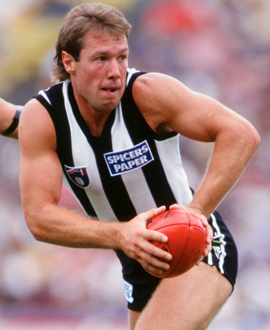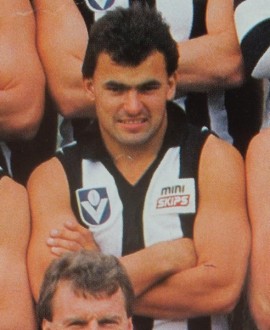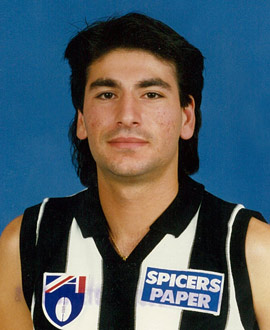By: Glenn McFarlane of the Herald Sun
Mick McGuane remembers it as the moment his Collingwood under 19s team was linked to the man who would ultimately determine their destiny, Leigh Matthews.
It came in April 1986, in the days after Matthews replaced Bob Rose as senior coach, and McGuane credits it with part of his future success, and the bridge between the young up-and-coming Magpies and the man in charge of the club's direction.
McGuane was 18 at the time, having come to the club from Sebastopol, and already displaying good potential alongside some highly-rated teenagers in the club's "thirds", as the under 19s were sometimes called.
Among the group was a skinny kid from Templestowe devoid of fear (Gavin Brown), a big lump of a lad from Woori Yallock (Damian Monkhorst) and a resolute left-footer from Queensland (Gavin Crosisca).
Other likely lads brought together under the coaching of Keith Burns came from all parts of the state.
Plenty of them came from the fertile recruiting grounds of the northern suburbs, including captain Jason Croall, and Damian Keating from Bundoora, Athas Hrysoulakis from Lalor, Terry Keays from St Marys, Neil Brindley and Paul Smith, from Greensborough, as well as John Mrakov, from Preston Wanderers.
"We were a very close group (in the under 19s) and we felt as if we really connected to each other, and connected to the Collingwood Football Club," McGuane said.
"The first time that I felt really connected to the club, and a part of Collingwood, was when Leigh Matthews got the whole club together in the one room at Vic Park.
LIST: View profiles of those who won an under 19s best-and-fairest while playing for Collingwood.
"It was the whole club, too, and that included the under 19s. We all felt connected because we were included in it.
"He spoke about what he expected from us. He told us that, as an outsider looking in, he thought there were too many egotistical bastards in the room, and he was prepared to name them. It didn't matter that we were in the under 19s. We knew we were a part of what was happening at the club then and in the future."
Fast forward five months, to September 26, 1986 - 30 years ago this week - and the highly-rated Collingwood side defeated North Melbourne to win its fourth VFL under 19s premiership as the first game of a big day of football at the MCG, culminating in the Hawthorn-Carlton VFL Grand Final.
Coached by Keith Burns, a great tutor of young footballers, this Magpies under 19s team would prove to be one of the most celebrated, with four players going on to play in the first AFL Grand Final four years later on a day where Collingwood broke a 32-year premiership drought.
All four - Brown, Monkhorst, McGuane and Crosisca - played important roles that day in 1990, and had long and distinguished careers in black and white.
Others from that 1986 under 19s side had solid careers with the Magpies, 11 of the Grand Final team represented the club at senior level, and a number of them were very stiff not to play a league match, given how strong the competition was.
Many of them are still connected to the club - and to each other - as evidenced by the 30-year reunion alongside their former mentor Burns in early September.
"We've always been pretty close," Paul Smith, one of the team's best defenders, said. "We're all still close 30 years on."
Burns has always had the philosophy that developing players was more important than wining flags, but he knew this particular under 19s side had the talent and the temperament to achieve the ultimate success.
"We knew we had a good side, and we had a great year," Burns said recently. "We tried a lot of young players out that year and tried to develop them as players."
"We used to send them up to the seconds when they were ready to go. But the seconds that year (in 1986) weren't going to make the finals that year. We still sent some boys up to the seconds (Mark Orval and Paul Tuddenham), but we knew we were a chance to win the under 19s flag, so we kept a lot of the group together."
Incredibly as the season would later pan out, Collingwood's under 19s side started 1986 slowly, winning only three of the first nine games.
Two of the early defeats - one of them to North Melbourne - were floggings.
But somehow they clicked, and with Matthews keeping an eye on the young charges, and with Burns polishing their skills and their commitment, the Magpie thirds stormed home to finish third on the ladder, giving them the double chance by 0.01 per cent.
PREMIERS: The records of our under 19s team.
Better still, they knocked off Denis Pagan's highly-rated Kangaroos in the second semi-final, launching themselves in the premiership playoff.
Monkhorst admitted he was "a bit wild" in those days, but Burns was able to chisel off some of his rough edges.
One of those times came in a match against North Melbourne earlier in the year when the ruckman took offence at an opposition player having a go at him. Burns laughed when he recently recalled: "Monky was about to kill him, and I had to take him off just to settle him down."
The big man said he loved being a part of that side, saying: "I was just going out there having some fun ... We had a really good side."
"Mick McGuane was the greatest football brain I ever played with. Browny was the bloke you would just look at and admire as he was a really competitive bugger."
"But there were other guys in the team who should have been destined for long VFL careers, but for whatever reason, didn't get the chance. But some of them went onto really good careers in the suburban leagues."
McGuane credited Burns as the man who set the standards for that under 19s side, saying he taught them about professionalism.
"Burnsy was ruthless in his approach to get the best out of you," McGuane said. "And that was even more so for the country boys ... Burnsy was really hard on a lot of the country boys, and he was the making of us.
"I still love Keith dearly for what he did for us."
Smith, who would later go on to play reserves with Collingwood and Richmond, agreed: "Even after all these years, you realise Burnsy was the best coach I ever played under. He was hard, but he was fair, and he called a spade a spade. You knew where you stood."
McGuane added: "They were all champion blokes in that team - Browny, 'Croally', Greg Faull, Paul Smith, 'Bolts', Damian Keating, all of those boys."
"We just really connected as a group. We trained hard as a group, and that was an extension of Burnsy's demands. He just helped us evolve as players."
Burns was also confident after defeating North Melbourne in the second semi-final that the same result would follow in the Grand Final. His confidence was undented, even when the Kangaroos shot out to an early lead.
A massive brawl erupted before the first bounce, which centred on David Stagg, who had formerly played with North Melbourne, and who had penned Pagan a letter (not a complimentary one) before the Grand Final.
But the young Magpies reeled the Kangaroos in as the game wore on.
"We had a good rivalry with North Melbourne, but we always felt confident we would win it," Burns said. "We got far enough in front in the last five or so minutes, so we put an extra player in the defensive zone, and there was never going to be a chance that we would lose that game, I don't think."
McGuane agreed: "North Melbourne had Denis Pagan as coach and Mick Martyn, who had kicked a hundred goals that year (and three goals in the Grand Final), so they were a tough side to beat. But here was the opportunity that I had dreamt of since I was a kid. I had black and white running through my veins."
The Kangaroos never gave in, but the Magpies held on to win by 16 points - 12.11 (83) to 9.13 (67).
The young Collingwood side celebrated wildly on the MCG, had a victory lap and chaired Burns off the ground. They were even given a guard of honour as they went back to the Collingwood Social Club for "a few beers" that night.
But what came next was more important than what happened on that day 30 years ago.
In 1987, as the Magpies had an injury epidemic at the start of the season, Matthews had to look at the group of young talent from that under 19s side for senior selection. Four of the nine new faces for round one, 1987 had played in the under 19s premiership six months later - the previous year’s ‘thirds’ B&F winner Neil Brindley, Athas Hrysoulakis, Gavin Brown and Gavin Crosisca.
Brindley, 19, received a phone call from Matthews on the Friday night before the game, informing him he would shadow star Swan Barry Mitchell for the game.
He recalled: “It was a bit of a shock to be picked … I debuted with a number of under 19s players and also some recruits who came across (from interstate).”
“It was a very, very new side … I think it was the start of the building block for the 1990 premiership.”
Mitchell had had 35 touches and kicked three goals, which made for a busy afternoon for Brindley in what was his only game in Black and White.
“I managed to play the whole four quarters without being rested … I didn’t get picked the following week,” Brindley recalled.
It was a tough call on Brindley, who was an exceptionally good footballer, and a quality individual, as Mitchell was one of the most exciting players in the AFL.
Burns said of Brindley: "They (Collingwood) crucified him a bit, didn't give him much of a chance."
Hrysoulakis showed great promise, but never produced the consistency that once saw him touted as a future star. But Brown, Crosisca, McGuane (who debuted later that year), and Monkhorst (who played his first senior game in 1988) would make their mark on football's biggest stage.
Four years on from that under 19s premiership, those four were among the 20 players who helped to end one of Australian sport’s long-running and most embarrassing droughts.
And Burns, for one, felt exceptionally proud of the role he - and the under 19s side of 1986 - had played in that.


